Foot and ankle injuries can occur whether you live a passive or active lifestyle. These parts of the body are highly necessary for mobility to execute the activities of daily living (ADL).
Foot and ankle injuries can result from an underlying condition or an accident, leading to chronic pain and difficult compensatory movements.
Most employees, active individuals, and athletes often acquire foot and ankle injuries. Some opt for fast, easy, and temporary treatments to return to work or train shortly.
To get your injuries treated by credible medical professionals at a foot and ankle institute, visit their services to know which services or treatment is appropriate for your condition.
Brief Anatomy Description
The ankle and foot are composed of 26 bones, 34 joints, 100 muscles, tendons, and ligaments.
Their conjunction is classified as a synovial hinge joint with one-degree freedom motion (plantarflexion and dorsiflexion) – that works as a rigid lever and provides a stable support base.
Its primary functions include supporting superincumbent weight, controlling and stabilizing the leg, absorbing shock, conforming to varied terrains, operating machine tools and elevating the body.
Some also consider its role in substitution for the upper extremity (UE) function in the absence of arms or elbows.
All of the structures together to perform daily tasks efficiently and safely. Here is a guide to foot and ankle injuries and how to heal them:
Ankle Sprains

The most common type is the lateral ankle sprain due to inversion on a plantarflexed foot or a history of “rolling over” the ankle.
The anterior talofibular ligament (ATFL) is the most commonly injured ligament, second is the calcaneofibular ligament (CFL), and the last one is the posterior talofibular ligament (PTFL).
An ankle sprain is classified into three stages:
- Grade 1 – is the partial tear of the ATFL; the CFL and PTFL are intact. There’s a mild swelling with point tenderness on the lateral side.
- Grade 2 – is the complete tear of the ATFL and partial tear of CFL. There’s diffuse, moderate swelling and the presence of ecchymosis.
- Grade 3 – is the complete tear of the ATFL and CFL.
Grade 1 and 2 can be treated with rest, ice, compression, and elevation (RICE), non-steroidal anti-inflammatory drugs (NSAIDs), and analgesics.
Conservative treatment includes the early mobilization of the injured ankle to improve blood circulation and stretch the muscles and ligaments.
Most physicians or physical therapists incorporate taping, bracing, proprioceptive, range of motion (ROM), and strengthening exercises to heal ankle sprains.
Conservative treatment can be used in Grade 3 ankle sprain, but if it fails, a surgical reconstruction to repair the muscles and ligaments is needed as early as three months post-injury.
Modalities like transcutaneous electrical nerve stimulation (TENS), hot moist pack (HMP), or ultrasound can also be used to reduce swelling and pain.
Achilles Tendon Disorders
Achilles tendonitis is repetitive stress and motion causing inflammation and microtears of the tendon. It presents swelling and pain in the posterior ankle with or without activity.
Achilles tendon rupture results from the degeneration and breakdown of collagen fibers – the mechanism of injury (MOI) is the sudden push-off with an extended foot or forceful landing from a jump.
An audible snap with immediate swelling, ecchymosis, and weakness is usually felt.
Risk factors for these conditions include tight hamstring and heel cords, old age, and training errors.
The treatments for Achilles tendonitis are relative rest, ice, NSAIDs, and a short-term immobilization using a splint or brace.
Treatments such as bracing for 8 to 12 weeks and heel lifts can be used for Achilles tendon rupture treatment.
However, surgical tendon repair is reserved for active individuals or worse cases. Physical therapy (PT) rehabilitation is highly encouraged for people with Achilles tendon disorders.
Adherence to treatment, medication, and patient education can effectively treat them.
Peroneal Tendon Injury
There are two MOI for a peroneal tendon injury. First is tenosynovitis or ruptures repetitive forceful inversion – an inflammation or degeneration of a tendon or synovium.
Second is the subluxation or dislocation due to sudden dorsiflexion of the ankle and foot, usually resulting from a skiing injury.
They present painful swelling, sudden weakness, and the inability to move the foot and ankle actively. Tenosynovitis has the same treatment as for lateral ankle sprain.
In contrast, subluxation or dislocation warrants orthopedic evaluation for 4 to 6 weeks of immobilization.
In Conclusion
The foot and ankle injuries often raise queries about how they should be addressed.
Acute or chronic, mild or severe – you must opt to see a physician, specialist, or a physical therapist to treat and prevent the worsening of the condition.
This brief guide can help you determine your next step into achieving full recovery. Our daily tasks warrant foot and ankle activities, whether at home or work.
Make sure you seek proper medical treatments and adhere to them.

Sandra is a health blogger based in San Diego, California. She is passionate about living a healthy lifestyle. She loves being outdoors and exploring new places with her husband. She is a mom of two awesome kids and a dog named Luna!
